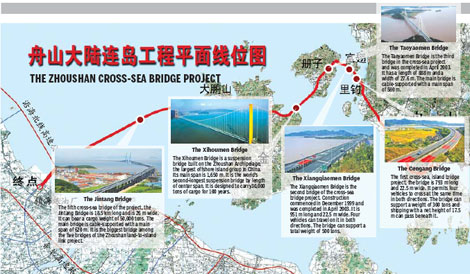Economy
Zhejiang: Bridge becomes popular beacon of growth
By JIA JINGQI (China Daily)
Updated: 2010-05-01 09:08
 |
Large Medium Small |
ZHOUSHAN, Zhejiang - "Night at the naval port, quiet and silent; sea waves sweep over the warships; and young sailors sleep soundly with sweet smiles ..."
So goes the famous song Night at the Naval Port, which evokes the coastal city of Zhoushan, Zhejiang province.

Nowadays, it is the major cross-sea bridge that brings the city nationwide fame.
The Zhoushan Cross-Sea Bridge, which officially opened to traffic last December, links Zhoushan, a city of nearly 1,400 islands, with the mainland - a long-cherished dream of its nearly 1 million people for almost 100 years.
The 50-km-long cross-sea bridge is currently the longest bridge of its kind in the country. It took 10 years to build at a cost of 10.6 billion yuan.
The bridge starts at Zhoushan island, passes the islands of Lidiao, Fuchi, Cezi and Jintang, traverses five watercourses, and links up with the national expressway network at Zhenhai district in Ningbo, an economic hub of Zhejiang.
"It has been operating smoothly since its opening at the end of last year, and the bridge has proved very popular with local residents," Yuan Xingjun, deputy director of the office of Zhoushan Cross-Sea Bridge Administration Bureau, told China Daily in an exclusive interview.
As of April 18, the bridge had received more than 1.01 million vehicles, with a peak of 21,000 cars a day, Yuan said.
An increasing number of businesses from Ningbo and other cities have established operations in the island city thanks to the bridge, said Chen Tongping, an official with the local economy and trade commission.
"To some extent, the bridge marks a milestone in Zhoushan's history, linking the less than 600-square-kilometer main island to the mainland as well as to the Yangtze River Delta area," said Zhou Guohui, mayor of the city.
With the bridge in place, it currently takes only three hours to travel from Zhoushan to Shanghai.
"The Zhoushan Archipelago, Zhejiang province, the Yangtze River Delta area and even the country as a whole will definitely benefit from the cross-sea bridge," Zhou said.
"In the long-term, the regional economy around the province and Yangtze River Delta are also expected to improve significantly."
Another cross-sea bridge, the second offshore passageway in the province, is set to connect Ningbo to Liuheng in Zhoushan.
"In the past, the port of Zhoushan could not fully exert its potential because of the inconvenient transport network. But now we have expanded Zhoushan's economic hinterland to Shanghai, Jiangxi, Anhui, and Jiangsu provinces as well as Zhejiang's other areas such as Ningbo, giving them easy access to sea transportation," said Luo Ning, vice-director of the Zhoushan Harbour Administration.
Zhoushan, as a point where the Yangtze, Yongjiang, and Qiantang rivers meet, has a strategic location on the Yangtze River Delta's comprehensive transportation network.
Rich in marine resources and boasting a long deep-water coastline of 280 km, Zhoushan Port has been listed among the top 10 ports in China for 10 years in a row.
The city's port industry has developed dramatically over the past 20 years, with its annual cargo handling capacity soaring from 1.92 million tons in 1990 to 193 million tons last year, Luo said.
Since the coordinated development plan of Zhoushan Port and Ningbo Port was initiated a few years ago, the city's port industry has continued to prosper.
The output of the city's maritime sector, including its port, marine energy, marine biology resources and related products, as well as sea-themed tourism, and logistics fields, reached 116.5 billion yuan last year, accounting for 67.2 percent of the GDP, much higher than the province's average 12.5 percent and the nation's 9.5 percent average, figures from the local development and reform commission showed.
The marine economy will continue to enjoy high priority in the city's development blueprint, Luo said.
The Zhoushan Marine Scientific City, with a planned area of more than 80 sq km, will be established as a platform to develop sea-related industries and the city will also develop its tourism, container port, new energy, and logistics industries.
CHINA DAILY







